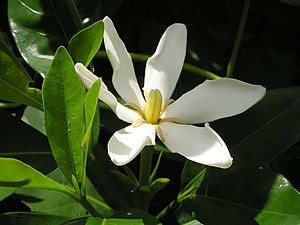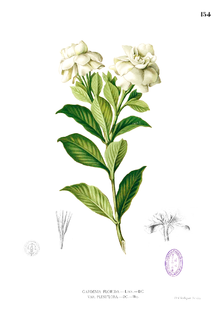gardenia
| gardenia | ||||||||||||
|---|---|---|---|---|---|---|---|---|---|---|---|---|

Gardenia ( Gardenia jasminoides ), unfilled flower |
||||||||||||
| Systematics | ||||||||||||
|
||||||||||||
| Scientific name | ||||||||||||
| Gardenia jasminoides | ||||||||||||
| J. Ellis |
The gardenia ( Gardenia jasminoides ) is a plant from the genus of gardenia ( Gardenia ) within the family of Rubiaceae (Rubiaceae). Their varieties are used as ornamental plants ; Because of its earlier use, especially in the Romantic era , it is also called buttonhole or flower gardenia .
description
The gardenia is an evergreen shrub . The leathery leaves are glossy and dark green. The very sweet smelling flowers are radial symmetry . The petals are initially white and gradually take on a creamy yellow color and a waxy surface. The flowering time in the area of origin is from December to March, as a cultivated plant it blooms from mid-spring to early summer. It makes orange berries .
The number of chromosomes is 2n = 22.
Occurrence
Gardenia jasminoides is distributed from Indochina to Taiwan and southern Japan .
Taxonomy
Synonyms for Gardenia jasminoides J.Ellis are: Gardenia augusta ( L. ) Merr. , Gardenia florida L. nom. illegal. superflat., Gardenia radicans Thunb. , Varneria augusta L. nom. nud.
Toxicity
All parts of the plant are considered poisonous, especially the fruits.
The main active ingredients are crocin , methyl anthranilate , the iridoid glycosides gardenoside, geniposide, genipin-1-β-gentiobioside, shanzhisid and others.
Symptoms of poisoning: Due to the content of iridoid glycosides, the fruit has a purgative effect. The aqueous extract shows a more toxic effect than the alcoholic one.
use
It is one of the medicinal plants in traditional Chinese medicine . In Chinese this species is called “Zhi Zi”. The scent of the flowers is reminiscent of jasmine , which is why they are used as a natural flavoring substance in teas and cosmetics (like those of Gardenia tahitensis (Tiare) in Tahiti as a component of monoi oil). An extract from the fruits is still used today as a natural color in cosmetic care products and occasionally as a food color , e.g. B. in fruit gums . This carotene dye was known under the name "Wongsky" more than 3000 years ago and was of great importance in the dyeing of silk .
A team led by the fragrance researcher Hanns Hatt from the Department of Cell Physiology at the Ruhr University Bochum has discovered a fragrance (2,4,6-trimethyl-4-phenyl-1,3-dioxane, gardenia acetal) that has a calming effect.
The gardenia is best known in the temperate latitudes as an ornamental plant in parks and gardens in frost-free areas and as a houseplant for cool rooms. It used to be popular as a cut flower .
sorts
A number of varieties have been bred, many of which have double flowers. Selection:
- Florida : up to 1 m in height and flowers with a diameter of almost 10 cm.
- Magnifica : does not flower as profusely as some other varieties.
- Prostrate : grows flat.
- Radicans : low with small flowers and leaves.
swell
Individual evidence
- ^ Edward F. Gilman: Gardenia jasminoides . Fact Sheet FPS-222, October, 1999
- ↑ Gardenia jasminoides at Tropicos.org. In: IPCN Chromosome Reports . Missouri Botanical Garden, St. Louis
- ^ A b Gardenia jasminoides in the Germplasm Resources Information Network (GRIN), USDA , ARS , National Genetic Resources Program. National Germplasm Resources Laboratory, Beltsville, Maryland.
- ↑ Rafaël Govaerts (ed.): Gardenia jasminoides. In: World Checklist of Selected Plant Families (WCSP) - The Board of Trustees of the Royal Botanic Gardens, Kew . Retrieved June 2, 2020.
- ↑ a b c Lutz Roth, Max Daunderer, Kurt Kormann: Toxic Plants - Plant Poisons. Occurrence, effect, therapy, allergic and phototoxic reactions. With a special section about poisonous animals. 6th, revised edition, special edition. Nikol, Hamburg 2012, ISBN 978-3-86820-009-6 .
- ↑ Olga A. Sergeeva, Olaf Kletke, Andrea Kragler, Anja Poppek, Wiebke Fleischer, Stephan Roger Schubring, Boris Goerg, Helmut L. Haas, Xin-Ran Zhu, Hermann Luebbert, Guenter Gisselmann, Hanns Hatt: Fragrant dioxane derivatives identify β1 subunit -containing GABA (A) receptors. In: The Journal of Biological Chemistry. 285, July 2010, pp. 23985-23993. doi : 10.1074 / jbc.M110.103309

